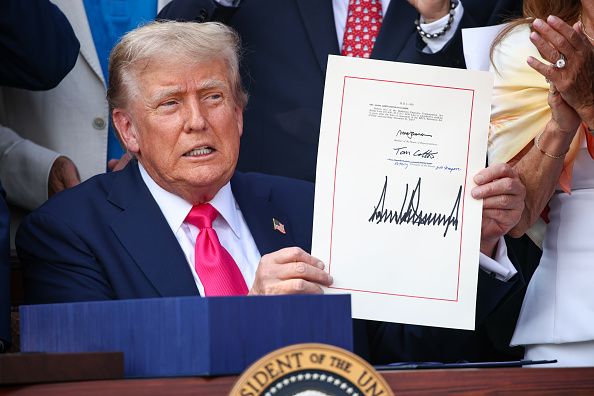Consumer Power Report #318
For the past year, we’ve been warning you about the evidence that Obamacare’s health insurance exchanges will be larger, and far more costly, than the administration originally claimed. The subsidies within the exchanges are simply too appealing, and it makes all too much mathematical sense for employers to shed coverage and push employees into the taxpayer-funded marketplace. Analyses from McKinsey, Cornell’s Richard Burkhauser, and others have suggested a significant number of employers will choose simply to pay the cheaper, more-predictable fine and shift their employees to the exchanges.
Now it appears the White House agrees. The administration’s most recent budget proposal includes a massive increase in the estimated costs of exchange subsidies, wiping out a major portion of any claimed savings from the law:
The White House’s fiscal year 2013 budget adds $111 billion in exchange spending between 2014 and 2021, with even more spending to come in future years.
For the years in which the two exchange budgets overlap – 2014 through 2021 – the White House states that it expects to spend $111 billion more in its new budget than it projected a year ago. In 2021 alone, the difference between the two budgets is almost $20 billion, implying that exchange spending will be up by over $200 billion in the decade following 2021.
There are a number of reasons this could be the case – Philip Klein cites one here.
One potential factor I’d flag is the deterioration of White House economic projections compared with a year ago. Higher than expected unemployment means more people are likely to get their health insurance through a government exchange. As I reported last month, at a hearing before the House Budget Committee:
Rep. John Campbell, R-Calif., asked (Congressional Budget Office director Doug Elmendorf) out the cost estimates for Medicaid spending and health insurance exchange subsidies would be effected now that CBO’s long-term unemployment forecast has deteriorated. Campbell noted that at the time of its original estimate, CBO was expecting an unemployment rate of 4.9 percent in 2014, but now that’s projected to be 8.7 percent.
“That piece alone would raise the cost of the Affordable Care Act,” Elmendorf said, referring to the formal name for the legislation. “I don’t know by how much.”
Already the folks on Capitol Hill are hopping on this, with Ways and Means Chairman Dave Camp (R-MI) announcing a probe of the matter. He writes in a letter to Treasury Secretary Timothy Geithner available here:
This staggering increase in health insurance exchange subsidy spending cannot be explained by legislative changes or new economic assumptions, and therefore must reflect substantial changes in underlying assumptions regarding the program’s utilization and cost.
Minority Leader Nancy Pelosi’s office responded to Camp’s letter by claiming the increase in the cost of the exchanges will be offset by reductions in the cost of Medicaid. That’s a fine thing to claim if you live in a land of make-believe. Any assumptions of decreased costs for Medicaid in a universe where 25 million people are added to the system by 2020, as CBO projects, are simply not based in reality. And either way – whether through increased Medicaid costs or exchange subsidies – these funds will come from the taxpayers.
— Benjamin Domenech
IN THIS ISSUE:
ARKANSAS REPUBLICANS UNHAPPY WITH LACK OF ACTION ON MEDICAID
States struggle to cope with increased financial burdens.
A Republican-backed proposal to shore up the Medicaid budget with surplus funds was defeated in committee in what was nearly a party-line vote. Gov. Mike Beebe and Democratic leaders said it would be premature to commit the funds during the fiscal session, while Republicans said failing to do something now means the crisis will only be worse when it hits.
“When you don’t deal with a problem when you have the ability to, it’s not going to go away. I think it will just get bigger,” said Rep. David Meeks, R-Conway.
State human services officials said last week that the state Medicaid budget could see a shortfall as high as $400 million in fiscal 2014. Beebe has questioned the projection, but he does expect a shortfall of more than $200 million.
Early in the three-week fiscal session, House Minority Leader John Burris, R-Harrison, proposed cutting $21 million in general-revenue spending from Beebe’s proposed $4.7 billion budget. Of that money, $14 million would have come out of a $114 million increase for Medicaid and would have been replaced with money from the state’s surplus.
Midway through the session, Sen. Jonathan Dismang, R-Beebe, proposed shifting $40 million in surplus funds to Medicaid now and 75 percent of the surplus, up to $60 million, to Medicaid next year.
Both proposals failed to gain traction in the face of opposition from Beebe and Democratic leaders. Burris was never able to get a committee vote on his measure, and Dismang’s was defeated in the Joint Budget Committee, largely by Democratic members.
“I was surprised to see that. I thought it was a good proposal,” Dismang said Friday, adding that he regretted the Legislature put off addressing the Medicaid crisis.
SOURCE: Arkansas News
Henry Miller writes in the Los Angeles Times:
There are many FDA regulatory issues that Congress should address. One is the agreement that gives the drug review and drug safety offices within the FDA equal responsibility for “significant safety issues” pertaining to medicines that are under review or have already been approved for marketing. The drug safety group is so narrowly focused on “safety” that it seems oblivious to the fact that because all drugs have side effects, safety cannot be evaluated in a vacuum. Instead, “safety” must be part of a risk-benefit judgment. The group’s motto might be: “If you don’t approve new drugs, you avoid safety problems with them.” These drug safety zealots should be returned to a purely advisory role.
Another issue that should concern congressional overseers is that the FDA considers the “accelerated approval” route to be too lenient. Introduced two decades ago, this process permits the agency to issue a limited, or conditional, approval of a new drug that is intended for a “serious or life-threatening disease” and for which there is an “unmet medical need” – that is, no alternative treatment. Intended as a “quick on, quick off the market” mechanism if the original positive results don’t pan out, it has worked well and saved countless lives.
Congress could also outsource some of the FDA’s functions. Dozens of independent studies over several decades have recommended transferring some tasks performed internally by the FDA to outside experts.
In fact, there is already a successful (but largely ignored) model for the evaluation of clinical data by an independent laboratory. In a two-year pilot program that lasted from 1992 to 1994, the FDA contracted out reviews of supplements to new drug applications and compared the results of these evaluations to in-house analyses. In all five of the supplements reviewed by a nonprofit technical consulting company, the recommendations were congruent with the FDA’s own actions, and the process was faster and cheaper.
The European Union offers an apposite, successful example of outsourcing in the regulation of medical devices that relies heavily on various sets of product standards and typically does not involve government regulators directly in product oversight. For low-risk devices, manufacturers themselves are allowed to certify that their products meet the necessary standards. For higher-risk products, manufacturers must obtain third-party review from nationally accredited, private-sector, profit-making entities – “notified bodies” – that test products, inspect manufacturing systems and ultimately verify that EU standards have been met.
SOURCE: Los Angeles Times
BIG PHARMA’S ROLE IN THE CONTRACEPTION DEBATE
Peter Schweizer has an interesting point here.
Forget for a minute the religious question and look at who wins big here: Big Pharma. This mandate is not really about condoms or generic versions of “the pill,” which are available free or cheap in lots of places. This is about brand-name birth control drugs and other devices that some consumers swear off because they are too expensive. The Health and Human Services (HHS) mandate requires health-insurance companies provide contraceptive coverage for all “FDA approved contraceptive methods.” It does not insist on generics. And it does not offer any cost containment.
What’s more, the mandate prevents health-insurance companies from having copays or deductibles for the benefit. This is the perfect set up for Big Pharma. Since the drugs will be paid for by a third party (insurance companies, who will pass the cost on to employers and the rest of us), the consumer won’t worry about the price. Expensive brand names will no doubt see demand rise. Ask more health-care analysts why the cost of medical services continues to rise so rapidly and near the top of the list is the fact that a third-party payment system won’t contain costs.
Back in 2009, many observers were surprised when Big Pharma came out in favor of President Obama’s health-care reform bill. The industry spent millions running television ads in favor of the law and industry lobbyists pushed hard for it. One important reason they did so was the promise that with the new law they would have a new market of millions of new customers. The contraceptive mandate is a perfect example.
As Roger Pilon notes at Cato’s blog, this mandate is about anything but contraception.
SOURCE: The Daily Beast
DO HOSPITAL MERGERS LEAD TO HIGHER PRICES?
An interesting point from Margot Sanger-Katz of the National Journal regarding Chicago’s experience:
The merger of three hospitals in Chicago is illustrative of the danger of this occurrence in the health care industry: Evanston Northwestern Health Care, a two-hospital group, sought to merge with Highland Park Hospital in 1999. Directors of each hospital eventually approved the move with the understanding that by uniting, the hospitals would improve the leverage of their positions and be able to negotiate better rates from insurance providers. This proved true, as after the first year the three-hospital group saw $24 million in increased revenue – about a 3 percent lift overall.
This trend continued: Within four years, the group had raised the price of care by as much as 48 percent, according to a government analysis.
The negotiation that takes place between care providers (such as the above-mentioned hospital group) and insurance providers equates to a discussion of the prices consumers will pay. When insurance companies see their prices driven up by powerful, monopolistic health groups, these price hikes are passed onto consumers in the form of higher premiums.
The danger here is that the PPACA is set to ignite these tendencies among hospitals nationwide. Because the Act imposes burdensome regulations that increase administrative expenditures and threaten noncompliance costs, individual doctors and small practices are coerced into mergers.
There’s more from Avik Roy on this subject here.
SOURCE: National Center For Policy Analysis
FOUR BIG INSURERS RAKE IN CASH THANKS TO MASSACHUSETTS’S MANDATE
Consolidation:
The four largest health insurers in Massachusetts fared extremely well in 2011, as fewer people sought medical care and as insurers renegotiated provider contracts, which helped them stifle healthcare costs, the Boston Business Journal and Worcester Telegram & Gazette reported.
Blue Cross Blue Shield of Massachusetts, the state’s largest health insurer, which reported a net $136.1 million last year in 2011 – more than 10 times the $13.4 million it earned in 2010, according to The Boston Globe.
Harvard Pilgrim Health Care reported a 2011 net income of $93.5 million, up from $49.6 million the prior year. Part of Harvard Pilgrim’s success, according to CEO Eric Schultz, was its ability to lower the average premium increase base rate to 1.8 percent for April reinsurance renewals, compared to 3.8 percent a year ago. Additionally, Tufts Health Plan posted a net income of $87.6 million last year, an increase from $58.8 million in 2010. And Fallon Community Health Plan’s $38.5 million net income reversed it loss of $8.8 million the prior year.
SOURCE: Fierce Health Payer
The head of the Progressive Policy Institute writes:
Rather than accept that Ryan has made a major concession by joining forces with Wyden, some liberals and seniors lobbies are still trying to conflate Wyden-Ryan with the Wisconsin Republican’s original – and deeply flawed – voucher proposal. (Henceforth, Ryan I.) Their attempts to demonize Wyden-Ryan with the dreaded V-word are both inaccurate and unfair. It also obscures features of Wyden-Ryan that merit progressives’ support.
There are three crucial differences between these two approaches:
First, Wyden-Ryan retains traditional fee-for-service Medicare as a guaranteed option for retirees. Liberals take note: This is the Medicare equivalent of the “public option” you wanted President Barack Obama to include in his health reform proposal.
At the heart of Wyden-Ryan is premium support, a concept with liberal lineage that is intended to rein in Medicare’s explosive cost growth as the baby boomers retire. It would replace today’s open-ended subsidy for seniors’ medical bills with a fixed payment to help them buy health insurance – either from Medicare or private plans. Where Ryan I was about privatization, Wyden-Ryan is about competition
Second, Wyden-Ryan is adequately funded and adds a new catastrophic-care benefit. Ryan I’s puny voucher, in contrast, was set to grow only with inflation, creating a massive cost shift from government to retirees.
Rather than a fixed-growth index, Wyden-Ryan’s premium support reflects real-world health costs because it’s based on head-to-head competition between private plans and traditional fee-for-service. It pegs the government contribution to the second-lowest competitive bid or traditional Medicare – whichever is cheaper. If seniors choose plans that cost more than that benchmark, they would have to pay the difference; if they choose cheaper plans, they would pocket the savings.
Third, Wyden-Ryan provides strong consumer protections for Medicare beneficiaries. A new Medicare Exchange would oversee the competition between private plans and traditional Medicare for seniors’ business. Plans that engage in cherry-picking healthy seniors or deceptive marketing campaigns would be booted out of the exchange, while those that enroll a disproportionate share of high-risk seniors would get extra support.
In that respect, Wyden-Ryan is more like Obama’s Affordable Care Act, which also features health insurance exchanges, than Ryan I, which would have forced seniors to fend for themselves.
SOURCE: Politico





